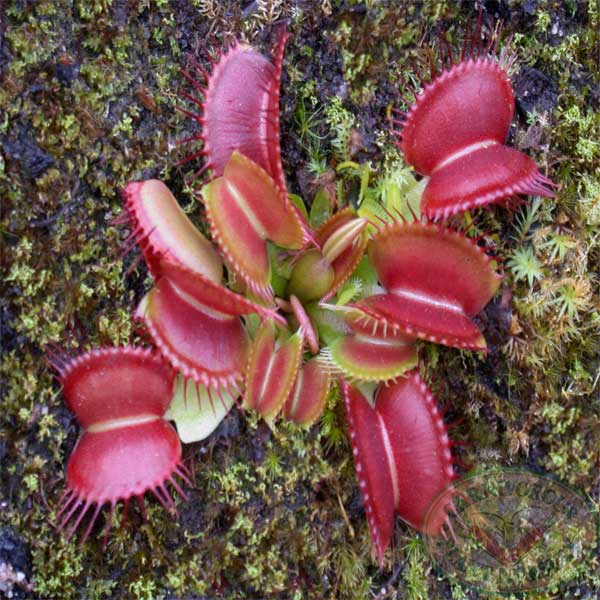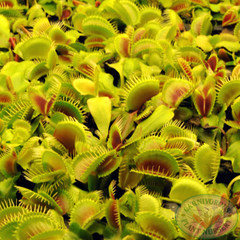
Venus Flytraps
Dionaea muscipula
The Venus Flytrap is probably the favorite of all Carnivorous Plants. The traps consist of two clamshell-like halves, lined with many stout guard hairs and minute nectar glands. In their resting position the traps are held open at 45°-60°. A healthy plant may have from 3 to 12 or more traps. The interior surface of each leaf is filled with microscopic digestive glands, giving the leaf surface a fine bumpy appearance. Each inner leaf half usually has three small delicate trigger hairs in a triangular pattern. Most of the time, for the trap to close, any one of these trigger hairs must be touched twice, or any two hairs touched one after the other. In very warm temperatures one touch may be enough. The longer the period between the two stimuli the slower the closure. The best closing response seems to happen when both stimuli occur within 40 seconds. Each trap will close about 3 times before it will no longer respond.
The time delay for trap closure seems to have some survival advantage. A single stroke caused by a brisk breeze or raindrop will not make the plant spend unnecessary closure energy on non-food. The double stroke will often allow prey to enter the center of the trap and be better positioned for capture. If the trap captures non-organic matter or misses its prey, it will open usually within 24 hours. A trap may take 3 to 5 days to completely digest entrapped prey.
The initial step of trap closure is generally quite fast. The trap seems to slam shut like a bear trap and lock the small prey in a barred tomb. The continual struggling of the prey inside the trap, initiates the slower, secondary step of closure which seals the tomb as the trap margins press tightly together. The trap becomes a flattened, stomach-like pouch. The struggling motion of the prey and the release of amino acids increase digestive activity. Total digestion takes about 3 to 5 days depending upon the size and nutrient content of the prey. Afterwards, the trap will reopen and the dried insect remains are released. Larger prey may be digested in several closures. Very small prey can escape through the tiny spacing between the outer guard hairs and save the plant from inefficient digestion. The complete sealing of the trap and the onset of digestion require the constant stimulation of live prey. An inanimate piece of cheese or hamburger, though organic, does not wiggle and will result in the reopening of the trap, leaving this "meal" undigested.
The exact mechanism of trap closure is not understood completely. Observation has shown that a stimulated trigger hair releases a small action potential or electrical current across the leaf. By itself, this single current is generally too weak to cause trap closure. However, a second stimulus soon enough after will increase the current to a level sufficient to close the trap. Closure actually appears to be from the rapid growth in the outer surface of the cells lining the trap exterior. This is probably the fastest cell growth known.
The trap does not close on a hinge like a bear trap. The trap acts more like a spring door. An open trap has a concave outer surface and a convex inner surface. During closure, the rapid growth of the cells on the exterior causes these surface features to reverse. The trap quickly closes and the guard hairs snare the prey.
Venus Flytraps grow in the wild in a very limited area near Wilmington, NC. They grow in moist, sandy, acid savannahs among the grasses, sedges and native orchids of the Cape Fear River Basin. Populations have naturalized in the New Jersey Pine Barrens, Florida, and other suitable habitat. Venus Flytraps will tolerate short periods of drought and flooding. They are among the first plants to grow back after a fire. In fact, a rapid surface fire in the autumn can actually benefit Venus Flytraps, by burning out competing shrubs and trees. The Venus Flytrap is rather hardy climatically. It can be grown outdoors in more northern latitudes, although in some areas it may require protective winter cover by mulching.
Dionaea flowers are white and cup-shaped with 5 petals. 4-10 flowers may form on a spike. Flowers appear in early summer. Seeds mature in late summer, and can be sown immediately or refrigerated and started in the spring.
Dionaea muscipula is an endangered species which cannot be legally collected from the wild. There are severe penalties in North and South Carolina for collection without a permit. The Venus Flytrap is also listed in Appendix II of the Convention on International Trade in Endangered Species (CITES). Plants in the wild are becoming increasingly uncommon, mostly due to suburban development and habitat destruction.
Dionaea are generally resistant to most pests. Watch out for aphids in early spring, and spider mites in the summer. Pests can be removed manually or treated with a dilute systemic general insecticide.
The origin of the name Venus Flytrap is obscure. It was first described botanically in 1768 by John Ellis in England. "Venus" either refers to its beautiful flower (Venus, the goddess of love and beauty) or its alien-like feeding habit. It was known in colonial days as "tipitiwitchet." "Meadow Clam" and "Aphrodite’s Mousetrap" are other names. All of which hint at the plant’s curious nature.




